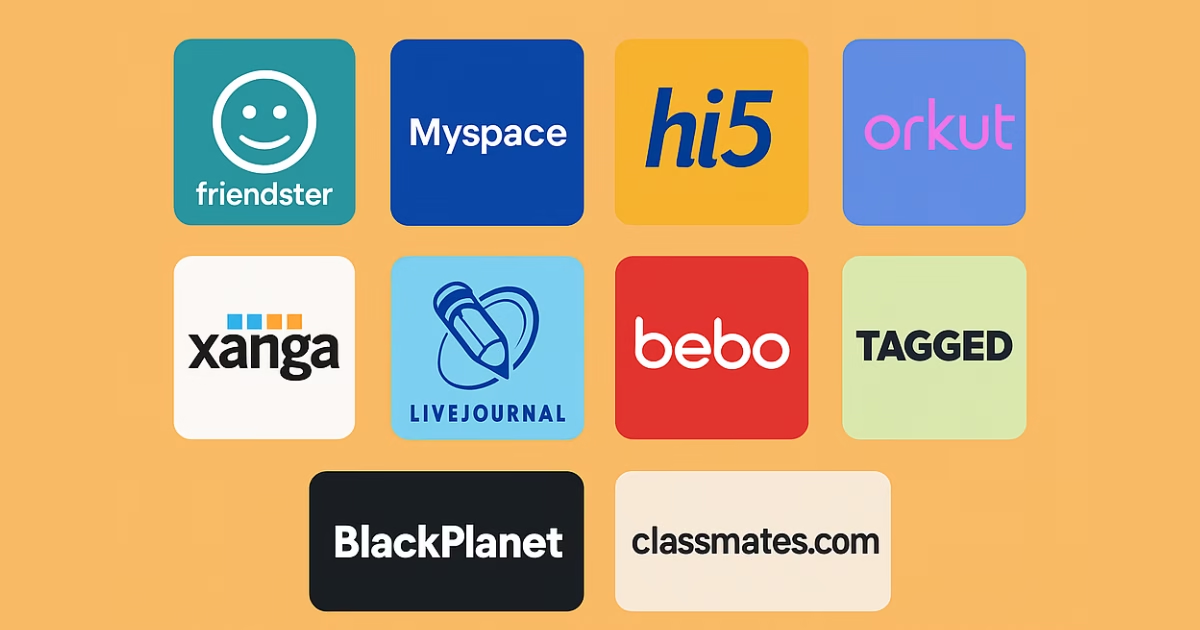Before Facebook ruled the internet, a different set of platforms shaped the way people connected online. The early 2000s were a golden age for digital experimentation, and many users found their first online friends through old social media sites 2000s users still remember with nostalgia. These platforms weren’t just websites — they were places to share music, post photos, write blog entries, and join online communities. From MySpace to Orkut, every site had its own charm and loyal fanbase. Even though most of them are now gone or forgotten, they laid the groundwork for the modern social media experience. Looking back at these platforms helps us understand how far social networking has come. Each one had something special, and for many people, those were the first steps into the digital social world.
A Deep Dive into Old Social Media Sites 2000s
The old social media sites 2000s offered something unique. Unlike today’s streamlined apps, these platforms were raw, creative, and often chaotic in design. But that’s what made them fun. Back then, people could change the layout of their profile, pick theme music, or write long public messages to friends. These sites didn’t focus on followers or likes. Instead, they encouraged people to build personal spaces online. Communities were at the heart of everything. Whether it was a fan group for a band or a discussion page for gamers, people gathered around shared interests. It wasn’t about going viral — it was about being part of something. While technology was slower and smartphones weren’t common, users still spent hours online. Even with dial-up internet, these platforms brought people together in ways that felt new and exciting.
Friendster – The One That Started It All (2002)
Friendster is often called the first real social media site. Launched in 2002, it introduced the idea of making online friends through mutual connections. The site allowed users to create a profile, post photos, and write messages to friends. It had a simple layout and focused on building a safe space for people to connect.
At its peak, Friendster had over 100 million users. People loved the idea of seeing “friends of friends” and forming online relationships. It was new, fun, and felt like the future. But soon, it started having problems. The site became slow. Pages wouldn’t load. And users began leaving.
One big reason for its decline was Facebook. When Facebook showed up with faster features and cleaner design, users switched quickly. Friendster tried to stay relevant by becoming a gaming site, but that didn’t last. Eventually, it shut down in 2011.
MySpace – When Everyone Was a Rockstar (2003)
MySpace changed everything. Launched in 2003, it was more than just a social network — it was a stage. Users could customize their profiles using HTML, add background music, and even include videos. It gave people total control over how their page looked and felt.
For musicians, MySpace was gold. Bands could post their songs, connect with fans, and grow a following. Many artists, like Arctic Monkeys and Lily Allen, got their start there. Even non-musicians felt like stars. A profile wasn’t just a page — it was a statement.
By 2006, MySpace was the most visited social site in the world. But as Facebook grew, people got tired of slow-loading pages and messy layouts. Facebook offered a cleaner, simpler design — and users left MySpace in large numbers. Despite trying to rebrand several times, MySpace never regained its past glory.
Orkut – Google’s Early Social Network (2004)
Orkut launched in 2004 as Google’s first attempt at social media. While it didn’t gain much traction in the U.S., it exploded in Brazil and India. Millions of users signed up, making it a cultural phenomenon in those countries.
Orkut had fun features like “scraps,” which were public messages, and “testimonials,” which friends could write about each other. It also had a strong focus on communities. Users joined groups based on interests, hobbies, or locations. These communities were lively, full of debates, jokes, and support.
For many, Orkut was the first real social media experience. But it wasn’t perfect. The design was clunky, and spam became a huge problem. Google didn’t invest much in improving the platform. Eventually, as Facebook became global, Orkut lost its user base. It was officially shut down in 2014, but it’s still remembered fondly by many.
Hi5 – The Global Favorite That Faded Away (2003)
Hi5 launched in 2003 and quickly became popular across Latin America, Southeast Asia, and parts of Europe. At one point, it was one of the top 20 websites in the world. It looked a bit like MySpace but had its own style.
Users could customize profiles, add friends, post pictures, and play games. The site also had a reputation for being fun and full of energy. Its design was colorful, and people loved showing off their profiles.
Hi5 tried to shift toward social gaming in 2009. It added new games and focused more on user interaction through play. But by then, Facebook had taken over much of the market. People wanted a smoother experience, and Hi5 started to feel outdated.
Though it still exists in a different form today, Hi5 is no longer a major player in the social media world.
Xanga & LiveJournal – When Blogging Was Social
Before Facebook timelines and Twitter threads, there was blogging. Xanga and LiveJournal gave people a way to share long thoughts, personal stories, and even poetry. Xanga launched in 1999 and grew slowly during the 2000s. LiveJournal started in 1999 as well but became more of a community space.
Users on both platforms treated their pages like public diaries. They shared feelings, experiences, and creative writing. The comment sections were often full of support. People connected through shared experiences, not just profile pictures.
LiveJournal also had “friends-only” posts, giving users control over privacy. It was a safe space for many, especially young people and fandom communities.
As shorter content became more popular and platforms like Twitter and Tumblr took over, these blogging networks lost momentum. But they remain important in the history of old social media sites 2000s.
Bebo – The UK’s Social Star (2005)
Bebo was launched in 2005 and quickly became a hit in the United Kingdom, Ireland, and New Zealand. Its clean design and ease of use made it attractive to teens and young adults.
Users could post photos, write blog entries, and send “luv” to their friends. It even had a whiteboard feature where friends could draw doodles on each other’s profiles. The site felt friendly and personal. Unlike the chaos of MySpace, Bebo had more structure.
In 2008, AOL bought Bebo for nearly $850 million, hoping to compete with Facebook. But things didn’t go as planned. Facebook kept growing, and Bebo didn’t evolve fast enough. Users left, and the site faded away.
Attempts to bring it back in later years failed to recapture the magic. Still, Bebo holds a special place in the hearts of many who grew up using it.
Tagged & BlackPlanet – Focused on Discovery & Identity
Tagged launched in 2004 with a slightly different goal — helping users meet new people rather than just connect with existing friends. It worked a bit like a mix between a social network and a dating app. Users could browse profiles, send messages, and play social games.
It didn’t gain massive popularity like Facebook but still built a strong user base. Later, it was part of a platform called “The Meet Group,” focusing more on social discovery and live streaming.
BlackPlanet, on the other hand, was designed for the Black community. It launched in 1999 and gave users a safe space to talk about culture, identity, and shared experiences. It offered forums, profile pages, and blogs. While not as flashy as other sites, its importance in online representation was huge.
Both platforms showed how social media could be more than just fun — it could be meaningful.
Classmates.com – Reconnecting Before Facebook
Classmates.com was one of the earliest social media-like platforms, launched in 1995 and gaining traction in the 2000s. It allowed people to find and reconnect with their high school or college classmates.
The platform focused on nostalgia. Users could view old yearbooks, send messages, and even plan reunions. For many, it was their first time using the internet to find people from the past.
However, the site had issues. It required a paid membership to see certain features, which turned off many users. Also, once Facebook allowed people to connect with school friends for free, Classmates.com became less useful.
Even though it still exists today, it never matched the reach of newer platforms. Still, in the history of old social media sites 2000s, it played a quiet but important role.
Why Did These Platforms Fail or Fade?
Most of these platforms failed because they couldn’t keep up. As technology improved, users wanted better speed, cleaner design, and new features. Many old social media sites 2000s struggled with slow loading times, spam, or poor updates.
Facebook came in with a clean look and smart features. It let users connect, share, and play — all in one place. Other sites couldn’t compete. They either shut down, changed direction, or became forgotten.
Some tried to reinvent themselves. MySpace tried music. Hi5 tried games. Friendster tried social discovery. But by then, users had already moved on.
The biggest lesson? In the fast world of tech, staying still means falling behind.
Legacy and Impact of Old Social Media Sites 2000s
Though they didn’t survive, the old social media sites 2000s helped shape the internet. They introduced the world to online profiles, status updates, and digital friendships. They taught developers what users liked — and what they didn’t.
Features we take for granted today started on those platforms. Custom profiles, blogging tools, online communities — these ideas didn’t come from nowhere. They were tested, loved, and sometimes broken on early sites.
Many people still remember the excitement of logging into MySpace, the joy of reading Orkut testimonials, or the thrill of getting “luv” on Bebo. These moments are part of internet history. And they helped create the world of social media we live in now.
Also Read: A Nostalgic Dive Into Early 2000s Social Media Trends
Conclusion
The old social media sites 2000s may be gone, but they left behind a digital legacy. They connected millions of people before smartphones and apps took over. They gave users control, creativity, and community in a way today’s platforms sometimes lack.
Even though the internet has moved on, these early platforms shaped how we talk, share, and connect online. Remembering them isn’t just about nostalgia — it’s about honoring the roots of a digital culture that continues to grow.

Hi, I’m Shafy Ali – a curious mind and passionate writer at Celiac Magazine. I cover a little bit of everything, from everyday tips and how-tos to deeper dives into topics that spark conversation. I enjoy turning research into readable, relatable content that informs and inspires. Whatever the subject, I aim to keep it clear, engaging, and genuinely useful.

